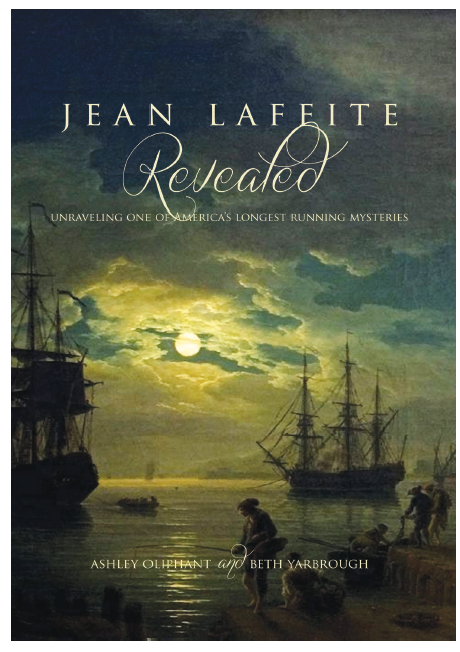The final fate of Jean Laffite has been a highly debated topic among historians and enthusiasts for over 100 years, but at long last, the mystery of what became of the well-known scoundrel who lived on Galveston Island from 1817-1821 may finally be solved.
The pirate/patriot/privateer was ordered off the island by the United States Navy in 1821 and sailed away on his ship The Pride into the mists of history, but conflicting legends and lack of documentation have clouded the waters of what happened next.
In their new book Jean Laffite Revealed: Unraveling One of America’s Longest Running Mysteries, Dr. Ashley Oliphant and Beth Yarborough recount their exciting search for clues that led them across several states, through libraries and archives, and into the surprising collections of a Masonic lodge. The mother daughter writing team incorporated their love of history, curiosity, and similar writing styles to bring this work together.
Yarborough’s affection for everything southern is reflected in her paintings and photography, which are licensed for use in the home and gift décor industry where she has worked for over 40 years. Oliphant, Yarborough’s daughter, is an English professor at Pfeiffer University in Misenheimer, North Carolina.
“I’m a Hemingway scholar and that’s what my doctoral dissertation was about,” says Oliphant. That project resulted in her first book, Hemingway’s Mixed Drinks. She has since written Sharktooth Hunting on the Carolina Coast, Hemingway and Bimini and In Search of Jimmy Buffet: A Key West Revival.
“I have been fascinated with pirates since I was a kid,” Oliphant shares. “I read every book I could find about Blackbeard and all of the pirates that had Carolina connections. I soaked up everything I could get my hands on. It wasn’t until later in life that I began to read Laffite biographies and had an eye toward writing a Laffite biography, because nothing new has been out in a little while.”
During a road trip to New Orleans, the pair was discussing the Laffite book project when their conversation turned to a familiar story.
“There had always been a longstanding legend here in our neck of the woods (North Carolina) about a man named Lorenzo Ferrer who from the time he arrived in the 1830s, was rumored to have been the pirate Jean Laffite under an assumed name,” relates Yarborough.
“Ferrer died in 1875 and the rumors have continued on until the present day,” she concludes. Although they assumed that the local legend had probably been thoroughly investigated at some point, they decided to include a second look at it to determine if it should be included in the book. Yarborough volunteered to help.
 “It was going to be a book that Ashley wrote alone, but because I am more local than she is—she lives 30 miles away—I told her I would dig around a little bit,” says Yarborough.
“It was going to be a book that Ashley wrote alone, but because I am more local than she is—she lives 30 miles away—I told her I would dig around a little bit,” says Yarborough.
“So we really just slid into it sideways thinking we were just double checking something. Well, lo and behold here’s all these things we began to uncover even locally that looked to us like new information that no one had actually put together. It just kept unfolding.“
“It was a 2-year-long research project that we worked almost full time,” relates Oliphant. “We went as far west as Texas and even on up into the northeast to find sources, and the majority of what we found was not digitized or catalogued.”
 “For the most part, everything we have written has been based on primary archival documents. We found deeds, census records, correspondence, marriage records, artifacts, and all kinds of things in places we wouldn’t have expected,” enthuses Yarborough.
“For the most part, everything we have written has been based on primary archival documents. We found deeds, census records, correspondence, marriage records, artifacts, and all kinds of things in places we wouldn’t have expected,” enthuses Yarborough.
Oliphant continues, “We had many of those (Laffite and Ferrer) documents and artifacts verified by experts before we published, so we feel good about the claims that we’re making about them in the book.”
The Galveston & Texas History Center at Galveston’s Rosenberg Library provided some of the photography used in the book. Two letters attributed to Lafitte are in the collections of GTHC as well. Unfortunately, no images of Ferrer exist, and the portrait most people associate with Laffite is widely discredited.
The women compiled and compared the known timeline of Laffite and that of Ferrer in North Carolina. “We wanted to make sure we could not place them in an identical time period together because that would have made everything a moot point,” explains Yaborough. Luckily for the project, the two men’s timelines did not converge, overlap, or cancel each other out.
“Then we began to look for documentation to extend those timelines toward each other, and gradually ended up where they met in the middle. That connection in the middle took us into Mississippi in the 1830s and the late 1820s in Cuba with documentation,” adds Oliphant.
Their book details the story of how they found proof in a prestigious institution that Jean Laffite did not die in the 1820s as many previous histories record. Oliphant refers to the information as “game changing.”
She explains, “Jean Laffite Unraveled covers what was previously known of Laffite, and then we transition to how we know he did not die when previously thought, and then we do a quick chapter about the journal. We had to address the journal issue obviously and then move into Mississippi which encompasses from about 1830 to 1837, and then the third part of the book moves into Lincolnton which runs 1839 to 1875.”
The journal to which Oliphant refers caused a stir in the research community when it first appeared. In the 1950s, a man claiming to be a descendant of Lafitte published The Journal of Jean Lafitte. It was republished in the 1990s. The writing claims he died in the 1850s and is buried in Alton, Illinois.
“I read the journal and had a bad feeling. It just didn’t feel like something he would do after years of trying to hide his identity,” says Oliphant. “Words and ideas that are mentioned in the journal were problematic.”
In one particular instance, the journal references something that was not even in existence at the time it was mentioned—it was about 100 years off. “If we had believed the journal was true,” Yarborough adds, “this project wouldn’t have happened.”
“While [Ferrer] was in Mississippi, he made the acquaintance of three brothers named Henderson from Lincolnton, North Carolina, who had come for the same reason,” says Yarborough.
“One of those men later went on to become the first governor of Texas, James Pinkney Henderson. When the cotton boom went bust in the late 1830s, Lorenzo Ferrer/Jean Laffite relocated to Lincolnton where he spent the last 35 years of his life. He stayed connected to the Henderson family until the day he died.”
“They actually vouched for him to get into the Masonic lodge in Lincolnton,” elaborates Oliphant. That particular Masonic lodge opened in 1852. The pair discovered early in their research that Ferrer had become a member there, and they were determined to access any information the lodge would share.
“After the members voted several times, we were given unrestricted access to their early log books which was truly extraordinary,” recounts Oliphant. Content with the wealth of information they extracted from the logs, they were surprised to receive a phone call from lodge members two months later. Although the members had always been aware that they had a War of 1812-era sword in their collection, it had been untouched for years.
“They said ‘we think you need to get up here,’ so we did!” smiles Oliphant. “Even the oldest men in the lodge said it had been hanging on a lodge wall ever since they had been there. That alone got us very excited because that’s the right time period for the Battle of New Orleans.”
Using a backlight to examine the sword, the researchers and attending discovered an inscription. Due to the object’s age and a varnish that had been applied over it, they were unable to immediately decipher the writing. As one of the lodge members read off the letters he could make out, the authors’ pulses raced. First he saw a capital “J” and then an “n” and then a fancy capital “L.”
“Beth and I both nearly fell on the floor,” Oliphant laughs. “When we were able to see the rest of the signature, it was spelled the way Jean Laffite always spelled his name: ‘Jn Laffite,’ not ‘Jean.’” The fact that the sword was discovered in the Masonic lodge where Ferrer was a member seems to support the researchers’ theories.
An expert in antique metals from Raleigh, North Carolina, whose specialty is analyzing inscriptions was brought in to examine the scabbard. Using specialized equipment, he was able not only to confirm what the group had seen with the backlight, but also to confirm that the age of the inscription is close to the age of the scabbard itself.
“He verified that it is an authentic War of 1812 sword, and said that the inscription had been scratched into the sword by an amateur using a sharp object,” Yarborough elaborates. We have enough evidence that we are very confident it is Jean Laffite’s sword, which we believe is part of his stolen inventory that he had appropriated for himself.”
“Ferrer got married in Mississippi and it was short lived, but there was [another] woman with him in Mississippi who came to North Carolina with him,” says Yarborough. “We found her on a Mississippi document, and that was one of the ways we knew it was the same Lorenzo Ferrer who had arrived here later, because she was with him in both places.
“She is buried in Lincolnton beside him,” remarks Oliphant. There is no evidence that either Laffite or Ferrer had any surviving offspring, but some locals in areas where the privateer lived often claim a genetic connection.
“We came into this with an open mind, and our minds remain open. It’s our opinion that good research is there to promote more research. And whatever that further research unveils is fine with us as long as it’s verified to be the truth. We are already at work on a sequel, because there is more to this story. The rest of Jean Laffite’s story is out there,” states Yarborough.
“Our book doesn’t do anything to the Galveston timeline,” assures Oliphant. “It’s after that that we have theories that are going to shake things up.”
They hope to come to Galveston in May on the Gulf Coast leg of their book tour to visit with the Laffite Society and visit the site of Laffite’s Galveston home Maison Rouge at 1714 Harborside Drive.
For updates on their book, visit the “Laffite Revealed” Facebook page, or order a copy from https://ulpress.org. Oliphant’s other books are linked on her Amazon Author Central page, and Yarborough’s art can be viewed at www.SouthernVoice.net.
Find out more about Laffite at the Pier 21 Theater movie The Pirate Island of Jean Laffite (409.763.8808), or on The Laffite Society Facebook page.